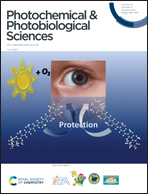Curcumin encapsulated colloidal amphiphilic block co-polymeric nanocapsules: colloidal nanocapsules enhance photodynamic and anticancer activities of curcumin
Abstract
Curcumin-based novel colloidal nanocapsules were prepared from amphiphilic poly(ethylene oxide)-block-poly(propylene oxide)-block-poly(ethylene oxide) (F108). These colloidal nanocapsules appeared as spherical particles with size ranging between 270 and 310 nm. Curcumin fluorescence spectra exhibited an aggregation-induced 23 nm red-shift of the emission maximum in addition to the enhancement of the fluorescence quantum yield in these nanocapsules. The cytotoxicity of curcumin and colloidal nanocapsules was assessed using human derived immortalized cell lines (A549 and A375 cells) in the presence and absence of light irradiation. The nanocapsules exhibited a >30-fold decrease in IC50, suggesting enhanced anticancer activity associated with curcumin encapsulation. Higher toxicity was also reported in the presence of light irradiation (as shown by the IC50 data), indicating their potential for future application in photodynamic therapy. Finally, A375 cells treated with curcumin and the nanocapsules showed a significant increase in single- and/or double-strand DNA breaks upon exposure to light, indicating promising biological effects.



 Please wait while we load your content...
Please wait while we load your content...